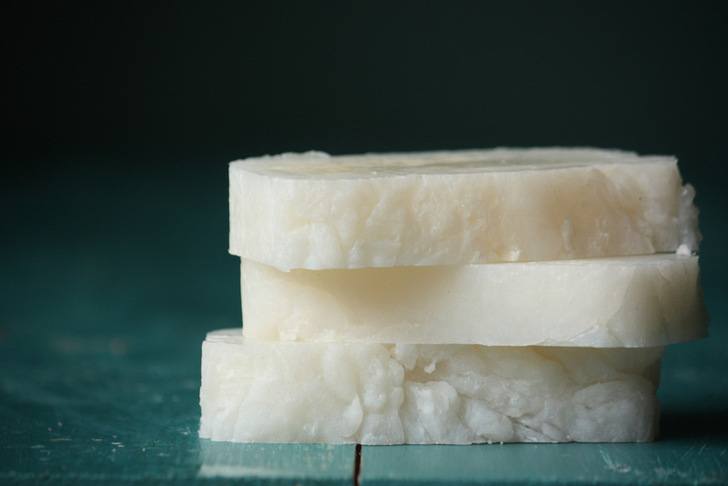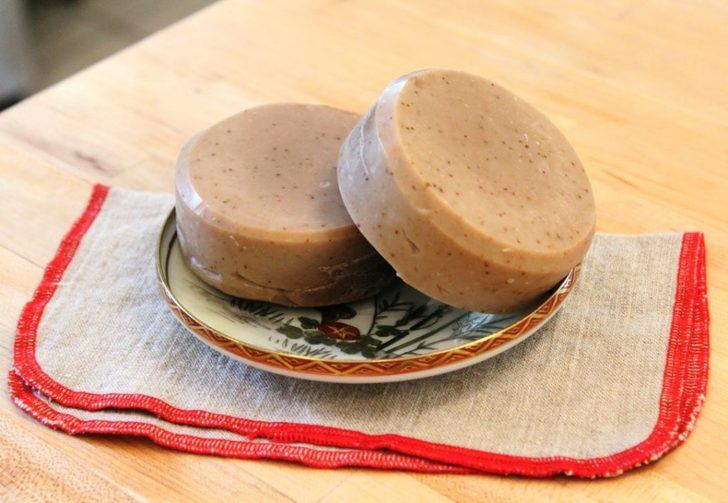
Fun, frugal, and infinitely practical, soap making is an art form where the potential ingredient combinations are practically endless. Using naturally skin-nourishing components, handcrafted soaps are enriched with vitamins, minerals, and beneficial oils that won’t’ dry out your epidermis like store-bought soaps have a tendency to do. If you’ve ever wanted to try your hand at making soap, read on!
A Quick Primer on Soapmaking:
At its core, soapmaking involves combining vegetable or animal fats with a strong alkaline, typically lye. The process, called saponification, is the chemical reaction between these two elements.
For the novice soapmaker, the “melt and pour” process is the easiest place to begin. Using a premade soap base, all you need to do is melt it down on the stove or in the microwave, then stir in fragrances, color, minerals, herbs, and whatever other ingredients your heart desires. Pour it into molds and let it cool for a few hours. Once it has hardened fully, it’s ready to be used.
More advanced soapmaking involves the traditional “cold process”. It requires the mixing of oils with a base solution, such as lye. Since lye is caustic and will burn your skin on contact, it’s important to follow these safety procedures before you begin. The upside of cold processed soap is you have more control over the ingredients you use and the soap will last much longer than melt and pour soaps. For the firmest bars, you’ll need to wait 4 to 6 weeks to allow the soap to fully cure.
Things You’ll Need:
Depending on the soapmaking process you choose, you should have these basic ingredients and tools on hand:
- Kitchen scale for accurate measurements
- Stainless steel mixing bowls, dedicated for soapmaking only
- Stainless steel measuring spoons
- Silicone molds
- Additives like essential oils, dried herbs, vegetable oils, and natural colorants like these.
- Soap base for the “melt and pour” method – goat’s milk, shea butter, or glycerin.
- Alkaline for “cold process” – lye or wood ash.
- Quick read thermometer
Homemade Soap Recipes:
1. Milk & Honey Soap

A quick DIY, this 10-minute melt and pour recipe incorporates the anti-aging, acne-fighting, clarifying, and moisturizing properties of raw organic honey with the skin soothing benefits of goat milk – no lye needed.
Get the recipe from Happiness is Homemade.
2. Tea Tree & Charcoal Facial Soap

Formulated for combination to oily skin types, this sleek and sexy black bar of soap contains the healing attributes of tea tree oil along with the detoxifying effects of activated charcoal. And the selection of skin-friendly oils like castor, coconut, palm, olive, and tamanu oils, ensures it’s also deeply hydrating.
See how it’s done at Soap Queen.
3. Pure Coconut Oil Soap

Requiring only four ingredients – coconut oil, water, lye, and your choice of essential oils – this basic soap is naturally moisturizing and cleansing. Using the wondrous process of “superfatting”, more coconut oil is added than the lye can convert to soap, creating a bar that is extra fatty and therefore moisturizing. This recipe can also be easily adjusted to make laundry soap as well.
Get the full instructions at Mommypotamus.
4. Aloe Vera Soap

With the ability to soothe sunburns, heal wounds, treat acne, moisturize, and defy the outward signs of aging, aloe vera is truly an amazing specimen and the perfect candidate for soapmaking. Harvest the gel from your own plant (or purchase organic aloe vera gel) and combine with coconut oil, shea butter, olive oil, lye, and lard to make this super nourishing soap.
See how it’s done at Mother Earth News.
5. Lavender Oatmeal Soap

A cure for dry, itching, and otherwise sensitive skin, this soap recipe combines the awesome powers of lavender with the reparative qualities of oatmeal. To make, you’ll need goat’s milk soap base, quick cook oats, dried lavender flowers and lavender essential oil.
Get the full instructions at Beauty Crafter.
6. Yogurt & Banana Soap

With the core ingredients of banana powder, flax seed oil, and powdered yogurt, this body bar is rife with potassium, vitamins A, E, and B6, essential fats, and lactic acid. An excellent cure for dry skin, it also contains coconut oil, castor oil, babassu oil, cocoa butter, shea butter, and olive oil.
Get the recipe from Soap Deli News.
7. Pink Himalayan Salt Grapefruit Soap

And in yet another way to put Himalayan salt to good use, this soap recipe calls for just three ingredients: pink Himalayan salt, goat milk soap base, and grapefruit essential oil.
See the recipe at a Pumpkin & a Princess.
8. Poppy Seed Soap

A poppy seed soap two ways! The lemon poppy seed version is a fantastic kitchen soap that will swiftly remove the odor of garlic and onion from the hands, while the almond poppy seed soap is akin to a lotion bar. Both are excellent exfoliants thanks to the poppy seeds.
Get the recipes at Gluesticks.
9. Hemp & Shea Soap

Hemp oil is rich in omega-3 and omega-6 fatty acids, both of which are critical components for healthy skin. This soap recipe incorporates plenty of fats (shea butter, lard, coconut oil, castor oil, olive oil, and hemp seed oil) along with a goodly amount of white kaolin clay to make it extra creamy and sudsy. Top with hemp hearts for the full decorative effect.
Find the full instructions at Humblebee & Me.
10. Coffee Soap

With an intoxicating aroma, this coffee soap is a melt and pour recipe. Using a goat’s milk base along with almond oil for conditioning, fresh coffee grounds for exfoliation, and your choice of fragrance (coffee cake or vanilla are both good picks), this one will surely perk you up in the morning.
Get the recipe from Imperfectly Happy.
11. Calendula Soap

Rich in antioxidants, the calendula plant has been used for centuries to heal, hydrate, and protect the skin. An excellent choice as an ingredient for homemade soap, this cold process recipe uses dried calendula petals (harvested from the plant or purchased here) infused in coconut, olive, and rice bran oil.
See how it’s done at Slow Living Essentials.
12. Soap Scrap Soap

A pennywise way to use up those bits of soap toward the end of the bar, all you need to do is save them up, chop or grate them, toss into a pot of water and set to a gentle boil. Once it’s nice and hot, pour into greased molds to cool. And voila, a brand new bar of soap!
See how it’s done at Instructables.
